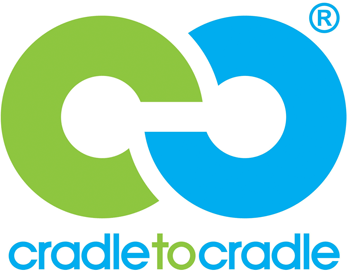Get to know Cradle to Cradle, DECLARE and five more…
by SUSAN HEINKING and CANDACE SMALL
In 2014, we presented TOXIC! Demystifying the Living Building Challenge’s Red List at the Greening the Heartland conference in Chicago. This month, we’re sharing an updated version of our TOXIC! Presentation on the VOA blog. Before we discuss toxic substances on the Red List, however, we’re going to look at the various third-party certification and labeling systems in use.
Why is it helpful to know about these labeling systems and certifications?
Understanding the toxicity of materials and products is crucial to sustainable design and project certification. The Materials & Resources section of LEED v4, for example, has taken a more comprehensive look at product and material evaluation. In credits such as “MRc4 building product disclosure and optimization – material ingredients”, LEED v4 encourages the use of products with Cradle to Cradle certifications or Health Product Declaration disclosures.
Below, we’ve collected seven of what we consider the most useful certification and labeling systems, standards, scorecards and ecolabels. We’ve also indicated which are voluntary, multi-attribute, or third party. So, here are our top picks, in order:
1. Cradle to Cradle
Independent third-party methodology evaluates products across five categories of human and environmental health
Cradle to Cradle, an independent third-party program, evaluates products over their entire life cycle from production to recycling or disposal. It looks at material health, material re-utilization, renewable energy and carbon management, water stewardship and social fairness. Product certification is awarded at five levels (basic, bronze, silver, gold and platinum). Cradle to Cradle extends beyond the built environment by evaluating materials in the fashion, product design and manufacturing worlds.
2. GreenScreen for Safer Chemicals
Hazard assessment and benchmark scoring system offers substitutions for hazardous chemicals
GreenScreen is an open source screening tool to promote the design, manufacture and use of safer chemicals in products based on authoritative scientific evidence. It is used internationally by industry, government and NGOs to support product design and development, materials procurement, and as part of alternatives assessment to meet regulatory requirements. Assessments, based on 18 human health hazard endpoints, can be done in-house or with independent profilers. GreenScreen has four levels: BM-1,2,3 and 4. GreenScreen helps identify safer alternatives whenever possible.
3. Healthy Product Declaration (HPD)
An open-standard for reporting product content
Run by a voluntary, membership industry non-profit, the open-standard HPD was created to promote consistent reporting of product and material content and health hazard information for building products and materials. Recognized by USBGC LEED standard, HPC serves as a base language for other interpretive tools. Products are assessed by manufacturers in-house using the GreenScreen List Translator (LT) to screen for hazardous Benchmark-1 chemicals. HPD increases transparency and accuracy by ensuring that both content and health information is reported consistently.
4. DECLARE – Living Building Challenge
A “nutrition label” for products and materials
Many regard the Living Building Challenge as the most rigorous green building certification to achieve. The International Living Future Institute launched Declare in 2012 as a simple system focusing on product ingredients. Declare supports LBC’s Red List (which we will talk about in our next Sustainability blog post) and Appropriate Sourcing Imperatives.
LBC says Declare creates “a platform for constructive conversations about the human health” in one easy-to-read label. This label features information on assembly location, life expectancy and end of life options (from take back to recyclable to hazardous). Raw Material and Final Assembly locations assist project teams in meeting the Appropriate Sourcing Imperative. Ingredients listed include all constituent parts of a product. Items are color coded (red, orange or black) to communicate potential hazards. DECLARE includes CSI Master Format 2010 classification and verified declaration of status in regard to the Living Building Challenge Red List, which makes it easy to use when specifying products on a job.
The free database Declareproducts.com is meant to encourage designers and consumers to make informed choices and give manufacturers an opportunity to demonstrate competitive advantage and a commitment to the health of clients and the community-at-large.
5. SCS: Scientific Certification Systems
Neutral third-party firm awarding specific labels
Third-party firm SCS Global Services performs environmental certification, auditing, testing, and standards development for products from textiles to flooring to furniture, awarding an array of specific labels from pesticide-free to carbon-neutral across various industries. For example, specific SCS certifications exist for VOC-free particle-board and VOC-free office furniture.
6. Green Seal
Independent, non-profit, multi-attribute certification for products
Green Seal has been around since 1989 and certifies products for consumers and institutions on the basis of health, wellness and environmental effects. Green Seal covers building materials such as paint, lighting, windows, finishes and more. Green Seal allows manufacturers to back up their environmental claims with hard science.
7. GREENGUARD Label
Third-party certification of various products for emissions and air quality
UL Environment, a business division of Underwriters Laboratories administers GREENGUARD Label as a third-party company. It evaluates paints, flooring, materials and furniture for emissions and toxicity. This standard helps designers and contractors select products (paints, for example) with low VOC emissions that promote good indoor air quality.
NEXT UP: A closer look at the Red List substances.
Susan Heinking, AIA, NCARB, LEED AP O+M, is vice president and sustainability leader at Chicago-based VOA Associates Inc. She can be reached via e-mail at sheinking@voa.com.
Candace Small, AIA, NCARB, LEED AP BD+C, also focuses on sustainability, as well as healthcare, in VOA’s Chicago office. Like Heinking, Small was also selected as a ’40 under 40′ industry leader to watch by Building Design+Construction magazine.
Note: This article is from the BuiltWorlds Archives. Some links, images and text may not be as originally formatted.








Discussion
Be the first to leave a comment.
You must be a member of the BuiltWorlds community to join the discussion.